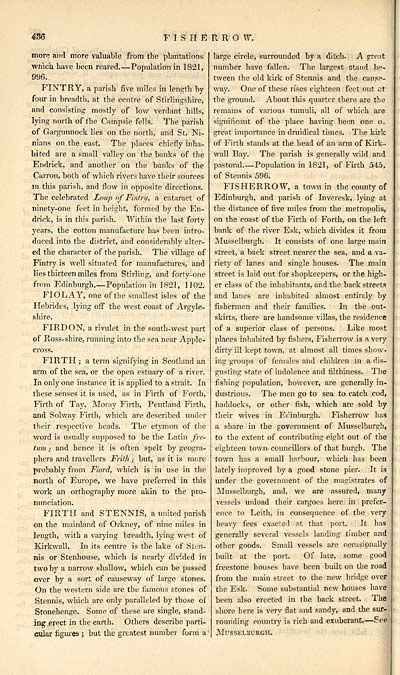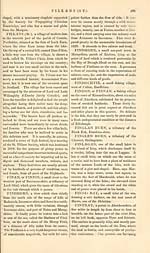Gazetteer of Scotland > Volume 1
(470) Page 436
Download files
Complete book:
Individual page:
Thumbnail gallery: Grid view | List view

F I S H E R R O W.
more and more valuable from the plantations
which have been reared. — Population in 1821,
996.
FINTRY, a parish five miles in length by
four in breadth, at the centre of Stirlingshire,
and consisting mostly of low verdant hills,
lying north of the Campsie fells. The parish
of Gargunnock lies on the north, and St. Ni-
nians on the east. The places chiefly inha-
bited are a small valley on the banks of the
Endrick, and another on the banks of the
Carron, both of which rivers have their sources
in this parish, and flow in opposite directions.
The celebrated Loup of Fintry, a cataract of
ninety-one feet in height, formed by the En-
drick, is in this parish. Within the last forty
years, the cotton manufacture has been intro-
duced into the district, and considerably alter-
ed the character of the parish. The village of
Fintry is well situated for manufactures, and
lies thirteen miles from Stirling, and forty-one
from Edinburgh.— Population in 1821, 1J02.
FIOLAY, one of the smallest isles of the
Hebrides, lying off the west coast of Argyle-
shire.
FIRDON, a rivulet in the south-west part
of Ross-shire, running into the sea near Apple-
cross.
FIRTH ; a term signifying in Scotland an
arm of the sea, or the open estuary of a river.
In only one instance it is applied to a strait. In
these senses it is used, as in Firth of Forth,
Firth of Tay, Moray Firth, Pentland Firth,
and Solway Firth, which are described under
their respective heads. The etymon of the
word is usually supposed to be the Latin f re-
turn ; and hence it is often spelt by geogra-
phers and travellers Frith ; but, as it is more
probably from Fiord, which is in use in the
north of Europe, we have preferred in this
work an orthography more akin to the pro-
nunciation.
FIRTH and STENNIS, a united parish
on the mainland of Orkney, of nine miles in
length, with a varying breadth, lying west of
Kirkwall. In its centre is the lake of S ten-
nis or Stenhouse, which is nearly divided in
two by a narrow shallow, which can be passed
over by a sort of causeway of large stones.
On the western side are the famous stones of
Stonnis, which are only paralleled by those of
Stonehenge. Some of these are single, stand-
ing jerect in the earth. Others describe parti-
cular figures ; but the greatest number form a
large circle, surrounded by a ditch. A grent
number have fallen. The largest stand be-
tween the old kirk of Stennis and the cause-
way. One of these rises eighteen feet out ct
the ground. About this quarter there are the
remains of various tumuli, all of which are
significant of the place having been one o.
great importance in druidical times. The kirk
of Firth stands at the head of an arm of Kirk-
wall Bay. The parish is generally wild and
pastoral Population in 1821, of Firth 545,
of Stennis 596.
FISHERROW, a town in the county of
Edinburgh, and parish of Inveresk, lying at
the distance of five miles from the metropolis,
on the coast of the Firth of Forth, on the left
bank of the river Esk, which divides it from
Musselburgh. It consists of one large main
street, a back street nearer the sea, and a va-
riety of lanes and single houses. The main
street is laid out for shopkeepers, or the high-
er class of the inhabitants, and the back streets
and lanes are inhabited almost entirely by
fishermen and their families. In the out-
skirts, there are handsome villas, the residence
of a superior class of persons. Like most
places inhabited by fishers, Fisherrow is a very
dirty ill kept town, at almost all times show-
ing groups of females and children in a dis-
gusting state of indolence and filthiness. The
fishing population, however, are generally in-
dustrious. The men go to sea to catch cod,
haddocks, or other fish, which are sold by
their wives in Edinburgh. Fisherrow has
a share in the government of Musselburgh,
to the extent of contributing eight out of the
eighteen town- councillors of that burgh. The
town has a small harbour, which has been
lately improved by a good stone pier. It is
under the government of the magistrates of
Musselburgh, and, we are assured, many
vessels unload their cargoes here in prefer-
ence to Leith, in consequence of the very
heavy fees exacted at that port. It has
generally several vessels landing timber and
other goods. Small vessels are occasionally
built at the port. Of late, some good
freestone houses have been built on the road
from the main street to the new bridge over
the Esk. Some substantial new houses have
been also erected in the back street. The
shore here is very flat and sandy, and the sur-
rounding country is rich and exuberant. — See
Musselburgh.
more and more valuable from the plantations
which have been reared. — Population in 1821,
996.
FINTRY, a parish five miles in length by
four in breadth, at the centre of Stirlingshire,
and consisting mostly of low verdant hills,
lying north of the Campsie fells. The parish
of Gargunnock lies on the north, and St. Ni-
nians on the east. The places chiefly inha-
bited are a small valley on the banks of the
Endrick, and another on the banks of the
Carron, both of which rivers have their sources
in this parish, and flow in opposite directions.
The celebrated Loup of Fintry, a cataract of
ninety-one feet in height, formed by the En-
drick, is in this parish. Within the last forty
years, the cotton manufacture has been intro-
duced into the district, and considerably alter-
ed the character of the parish. The village of
Fintry is well situated for manufactures, and
lies thirteen miles from Stirling, and forty-one
from Edinburgh.— Population in 1821, 1J02.
FIOLAY, one of the smallest isles of the
Hebrides, lying off the west coast of Argyle-
shire.
FIRDON, a rivulet in the south-west part
of Ross-shire, running into the sea near Apple-
cross.
FIRTH ; a term signifying in Scotland an
arm of the sea, or the open estuary of a river.
In only one instance it is applied to a strait. In
these senses it is used, as in Firth of Forth,
Firth of Tay, Moray Firth, Pentland Firth,
and Solway Firth, which are described under
their respective heads. The etymon of the
word is usually supposed to be the Latin f re-
turn ; and hence it is often spelt by geogra-
phers and travellers Frith ; but, as it is more
probably from Fiord, which is in use in the
north of Europe, we have preferred in this
work an orthography more akin to the pro-
nunciation.
FIRTH and STENNIS, a united parish
on the mainland of Orkney, of nine miles in
length, with a varying breadth, lying west of
Kirkwall. In its centre is the lake of S ten-
nis or Stenhouse, which is nearly divided in
two by a narrow shallow, which can be passed
over by a sort of causeway of large stones.
On the western side are the famous stones of
Stonnis, which are only paralleled by those of
Stonehenge. Some of these are single, stand-
ing jerect in the earth. Others describe parti-
cular figures ; but the greatest number form a
large circle, surrounded by a ditch. A grent
number have fallen. The largest stand be-
tween the old kirk of Stennis and the cause-
way. One of these rises eighteen feet out ct
the ground. About this quarter there are the
remains of various tumuli, all of which are
significant of the place having been one o.
great importance in druidical times. The kirk
of Firth stands at the head of an arm of Kirk-
wall Bay. The parish is generally wild and
pastoral Population in 1821, of Firth 545,
of Stennis 596.
FISHERROW, a town in the county of
Edinburgh, and parish of Inveresk, lying at
the distance of five miles from the metropolis,
on the coast of the Firth of Forth, on the left
bank of the river Esk, which divides it from
Musselburgh. It consists of one large main
street, a back street nearer the sea, and a va-
riety of lanes and single houses. The main
street is laid out for shopkeepers, or the high-
er class of the inhabitants, and the back streets
and lanes are inhabited almost entirely by
fishermen and their families. In the out-
skirts, there are handsome villas, the residence
of a superior class of persons. Like most
places inhabited by fishers, Fisherrow is a very
dirty ill kept town, at almost all times show-
ing groups of females and children in a dis-
gusting state of indolence and filthiness. The
fishing population, however, are generally in-
dustrious. The men go to sea to catch cod,
haddocks, or other fish, which are sold by
their wives in Edinburgh. Fisherrow has
a share in the government of Musselburgh,
to the extent of contributing eight out of the
eighteen town- councillors of that burgh. The
town has a small harbour, which has been
lately improved by a good stone pier. It is
under the government of the magistrates of
Musselburgh, and, we are assured, many
vessels unload their cargoes here in prefer-
ence to Leith, in consequence of the very
heavy fees exacted at that port. It has
generally several vessels landing timber and
other goods. Small vessels are occasionally
built at the port. Of late, some good
freestone houses have been built on the road
from the main street to the new bridge over
the Esk. Some substantial new houses have
been also erected in the back street. The
shore here is very flat and sandy, and the sur-
rounding country is rich and exuberant. — See
Musselburgh.
Set display mode to: Large image | Transcription
Images and transcriptions on this page, including medium image downloads, may be used under the Creative Commons Attribution 4.0 International Licence unless otherwise stated. ![]()
| Gazetteers of Scotland, 1803-1901 > Gazetteer of Scotland > Volume 1 > (470) Page 436 |
|---|
| Permanent URL | https://digital.nls.uk/97430002 |
|---|
| Description | Volume I: Abbey to Glenartney. |
|---|---|
| Attribution and copyright: |
|
| Description | By Robert Chambers and William Chambers. Glasgow: Blackie & Son, 1838. 2 volumes. |
|---|---|
| Shelfmark | NF.1461.g.7 |
| Additional NLS resources: | |

